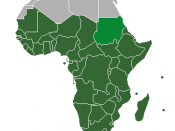Sub-Saharan Africa is made up of about ten percent of the world's population. In 2001, two-thirds of the 40 million people living with HIV resided in this region (Hearing 2). Only in Sub-Saharan Africa is this epidemic not concentrated to certain risk groups. The HIV virus is indiscriminate to all of the people living there with almost the same number of women affected as men (De Cock Mbori-Ngacha, Marum). With this epidemic happening to one particular region, one should look at the conditions of this region to find out why HIV is so prevalent. With no funds being generated for educational investment, and a region that has cultural obstacles in the way of finding a solution to the prevention of HIV/AIDS, there is little hope if nothing is improved. Due to poor economic conditions and lack of ethical behaviors, Sub-Saharan Africa is losing its' fight against HIV/AIDS.
Sub-Saharan Africa's economic situation has developed from various sources.
Some of the countries in this region have, or still are, engaging in war. As a result, funds are being reallocated from healthcare and education to fund these wars. War also leaves the society with weak or no infrastructure. Buildings that were once hospitals or schools lay in ruins and debris. These governments now must rebuild the infrastructure that was previously there so they can go on with daily activities providing healthcare and education of their people (Righi).
Most of the countries in Sub-Saharan Africa just recently gained their independence from overruling foreign governments. After the foreign government left, the Africans were left with little or no government structure, and very few people educated enough to arrange a political organization. With little structure, it was hard for Africans to put together healthcare and educational programs. Also, it was difficult for them to coordinate...



Nicely done
Very organized essay and lots of research. This is a great essay with key points. Also has works cited to back up the information.
4 out of 4 people found this comment useful.